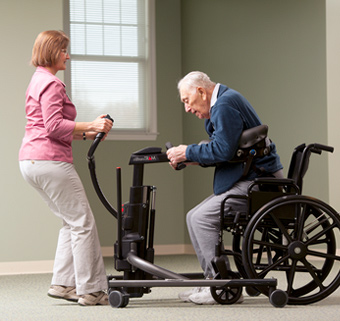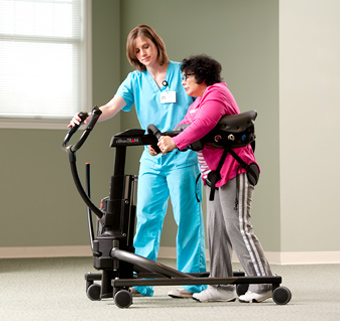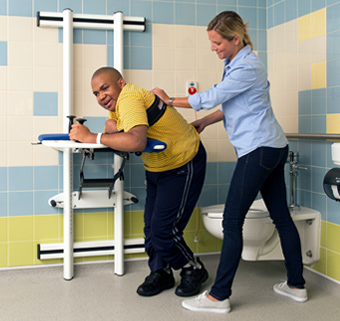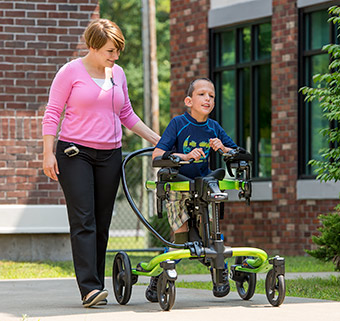Physical Activity, Disability and Health
Stepping Towards Inclusive and Effective Movement Initiatives
| November 2020 As a physical therapist and instructor of a middle school physical education class, I see the value of fitness and functional enhancement firsthand. Children of all abilities benefit from physical activity, and I particularly focus on children with developmental or cognitive issues that may prevent them from joining standard family activities or physical education initiatives.
As a physical therapist and instructor of a middle school physical education class, I see the value of fitness and functional enhancement firsthand. Children of all abilities benefit from physical activity, and I particularly focus on children with developmental or cognitive issues that may prevent them from joining standard family activities or physical education initiatives.
When it comes to health and wellness, this population is vulnerable. Statistics are against them; a lack of independent mobility options predisposes them to cardiovascular problems, muscular weakness, fractures and obesity.1, 2, 3, 4 Without appropriate intervention, these children will see a cycle of declining health and decreasing function progressing into adulthood.5, 6, 7, 8
But we also know that this cycle can be reversed or at least slowed and attenuated through daily mobility and activity participation.1, 9, 10, 11, 12, 13 The Mobility Opportunities Via Education (MOVE™) Program is an excellent example of activity-based intervention for improvement of mobility skills and general health. The aim of this approach is to coach children with physical and cognitive disabilities towards their fullest independent potential in all areas of life with an emphasis on skills practice and upright positioning. And they do it well, weaving frequent and repetitive opportunities for supported standing, walking and toileting into classroom, home and community routines. Within this program children thrive, often surprising their doctors with their gains in walking, sitting or standing abilities, reflecting improvements in overall strength, balance and endurance.14,15
The MOVE Program focuses on goal-oriented intervention and contextual learning. Children help set personal goals, and steps toward achieving these goals become part of daily practice in every-day environments. Their goals can be modest: a wish to dance the father-daughter dance at prom night, or to learn to walk to the bathroom so mom doesn’t have to do so much lifting. Research tells us that activities arranged around a child’s goals have the best outcomes because of buy-in from the child and the family.16, 17, 18 Collaborative goal-setting should be a primary consideration when implementing activity routines for children with disabilities.
Another strong motivator is an environment of inclusion or participation. Every child wants to be involved with their peers and their families whether in swimming, bike riding, playing soccer or baking cookies at the kitchen counter. With the right support and creative thinking the impossible can be achieved. Take for example Madi. With a diagnosis of spina bifida, she is unable to walk or move unaided. Provided with a mobile stander, a tutu and a few weeks of practice though, she’s anyone’s match on the dance floor.
Adaptive equipment bridges the gap between a state of functional impairment and one of inclusion and mobility. Supported in gait trainers, standers or adaptive tricycles, children are upright, interactive and involved in the fun of family and classroom activities. These opportunities are valuable for a child’s health and well-being, with byproducts of improved strength, stamina and social skills.
Research is positive towards the use of adaptive equipment for enhancing physical fitness. We see gait trainers and the supported ambulation practice that goes with them improving the walking speed, endurance and gross motor function of children with cerebral palsy.19 Similarly, adaptive standers help children improve bone mineral density, hip stability, range of motion, and reduce spasticity.20 Then there are adaptive tricycles. Although they may seem recreational to the layperson, their physical benefits for the child with disabilities cannot be ignored. A recent systematic review points to the finding that adaptive tricycles improve the muscle strength, balance and gross motor function of children with cerebral palsy.21 Keep in mind that these children, if not in adaptive equipment, would otherwise be mostly sedentary.
Although not everyone is trained to intervene therapeutically, nothing prohibits creative thinking and providing supportive and inclusive activity environments for the child with disabilities. In fact, there are exciting ways to facilitate movement and strength in this population – while including them in activities of their peers and working towards their goals. Please join my colleague, Lori Potts, PT as she shares inspirations and ideas towards creating inclusive environments and effective functional fitness initiatives for children in adaptive equipment, to encourage better health and quality of life.
Watch Get Active, Get Ahead:
This webinar was not submitted for prior-approval for CEUs. The CEU approval process is different in each state. Contact your state association or state board regarding contact hour requirements. A certificate of attendance is available upon request.
References
- Rimmer JH. Health promotion for people with disabilities: the emerging paradigm shift from disability prevention to prevention of secondary conditions. Phys Ther. 1999;79(5):495-502.
- Pitetti KH, Yarmer DA. Lower body strength of children and adolescents with and without mild mental retardation: A comparison. Adapt Phys Activ Q. 2002;19(1):68-81.
- Cervantes CM, Porretta DL. Physical activity measurement among individuals with disabilities: A literature review. Adapt Phys Active Q. 2010;27(3):173-90.
- Kim SJ, Kim SN, Yang YN, Lee IS, Koh SE. Effect of weight bearing exercise to improve bone mineral density in children with cerebral palsy; a meta-analysis. J Musculoskelet Neuronal Interact. 2017;17(4):334.
- Hanna SE, Rosenbaum PL, Bartlett DJ, et al. Stability and decline in gross motor function among children and youth with cerebral palsy aged 2 to 21 years. Dev Med Child Neurol. 2009;51(4):295-302.
- Schwartz MH, Viehweger E, Stout J, Novacheck TF, Gage JR. Comprehensive treatment of ambulatory children with cerebral palsy: an outcome assessment. J Pediatr Orthoped. 2004;24(1):45-53.
- Rosenbaum PL, Russell DJ, Cadman DT, Gowland C, Jarvis S, Hardy S. Issues in measuring change in motor function in children with cerebral palsy: a special communication. Phys Ther.1990;70(2):125-31.
- Findlay B, Switzer L, Narayanan U, Chen S, Fehlings D. Investigating the impact of pain, age, Gross Motor Function Classification System, and sex on health-related quality of life in children with cerebral palsy. Dev Med Child Neurol. 2016;58(3):292-97.
- Daly C, Moore C, Johannes S, Middleton J, Kenyon L. Pilot evaluation of a school-based programme focused on activity, fitness and function among children with cerebral palsy at GMFCS level IV: Single-subject research Physiother Can. 2020;72(2):195-204.
- Damiano D. Activity, activity, activity: rethinking our physical therapy approach to cerebral palsy. Phys Ther. 2006;86(11):1534-40.
- Novak I, Morgan C, Fahey M, Finch-Edmondson M, Galea C, Hines A, et al. State of the evidence traffic lights 2019: systematic review of interventions for preventing and treating children with cerebral palsy. Curr Neurol Sci Rep. 2020;20(2)3.
- Eisenberg S, Zuk L, Carmeli E, Katz-Leurer M. Contributions of stepping while standing to function and secondary conditions among children with cerebral palsy. Pediatr Phys Ther. 2009;21(1):79-85.
- Wilson PE, Clayton GH. Sports and Disability. PM&R.2010;2(3):S45-S54.
- Bidabe L. MOVE, Mobility Opportunities Via Education. MOVE International; 1999.
- Trombeta Reis C, Rubo de Souza Nobre MI. The professionals’ perceptions about the MOVE® curriculum approach. Fisioter Pesq. 2014;21(2):133-38.
- Smits-Engelsman BC, Blank R, Van Der Kay AC, et al. Efficacy of interventions to improve motor performance in children with developmental coordination disorder: A combined systematic review and meta-analysis. Dev Med Child Neurol. 2013;55(3):229-37.
- Brogren Carlberg E, Lowing K. Does goal setting in activity-focused interventions for children with cerebral palsy influence treatment outcome? Dev Med Child Neurol. 2013;55:47-54.
- Brach JS, Perera S, Gilmore S, et al. Stakeholder involvement in the design of patient-centered comparative effectiveness trial of the “On the Move” group exercise program in community-dwelling older adults. Contemp Clin Trials. 2016;50:135-42.
- Booth AT, Buizer AI, Meyns P, et al. The efficacy of functional gait training in children and young adults with cerebral palsy: a systematic review and meta-analysis. Dev Med Child Neuro 2018;60:866-83.
- Paleg GS, Smith BA, Glickman LB. Systematic review and evidence-based clinical recommendations for dosing pediatric supported standing programs. Pediatr Phys Ther. 2013;25(3):232-47.
- Armstrong EL, Spencer S, Kentish MJ, Horan SA et al. Efficacy of cycling interventions to improve function in children and adolescents with cerebral palsy: a systematic review and meta-analysis. Clin Rehabil. 2019;33(7):1113-29.







